Surface Magnetization Reversal of Wiegand Wire Measured by the Magneto-Optical Kerr Effect
Abstract
:1. Introduction
2. Materials and Methods
3. Results and Discussion
4. Conclusions
Author Contributions
Funding
Acknowledgments
Conflicts of Interest
References
- Chizhik, A.; Stupakiewicz, A.; Maziewski, A.; Zhukov, A.; Gonzalez, J.; Blanco, J.M. Direct observation of giant Barkhausen jumps in magnetic microwires. Appl. Phys. Lett. 2010, 97, 012502. [Google Scholar] [CrossRef]
- Yano, N.; Oka, K.; Ogasawara, I.; Yamasaki, J.; Humphrey, F.; Furukawa, S. Large Barkhausen discontinuity of Co-Fe-Si-B amorphous films sputtered on polymer substrate. IEEE Trans. Magn. 1996, 32, 4532–4534. [Google Scholar] [CrossRef]
- Vazquez, M.; Gomez-Polo, C.; Chen, D.-X.; Hernando, A. Magnetic bistability of amorphous wires and sensor applications. IEEE Trans. Magn. 1994, 30, 907–912. [Google Scholar] [CrossRef]
- Rauscher, G.; Radeloff, C. Large Barkhausen jump in composite wires. IEEE Trans. Magn. 1991, 27, 5238–5240. [Google Scholar] [CrossRef]
- Malmhall, R.; Mohri, K.; Humphrey, F.; Manabe, T.; Kawamura, H.; Yamasaki, J.; Ogasawara, I. Bistable magnetization reversal in 50 µm diameter annealed cold-drawn amorphous wires. IEEE Trans. Magn. 1987, 23, 3242–3244. [Google Scholar] [CrossRef]
- Matsushita, A.; Takemura, Y. Power generating device using compound magnetic wire. J. Appl. Phys. 2000, 87, 6307–6309. [Google Scholar] [CrossRef]
- Abe, S.; Matsushita, A. Induced pulse voltage in twisted Vicalloy wire with compound magnetic effect. IEEE Trans. Magn. 1995, 31, 3152–3154. [Google Scholar] [CrossRef]
- Wiegand, J.R. Switchable magnetic device. U.S. Patent 4,247,601, 27 January 1981. [Google Scholar]
- Wiegand, J.R.; Velinsky, M. Bistable magnetic device. U.S. Patent 3,820,090, 25 June 1974. [Google Scholar]
- Chang, C.-C.; Chang, J.-Y. Novel Wiegand-effect based energy harvesting device for linear magnetic positioning system. Microsyst. Technol. 2020, 26, 3421–3426. [Google Scholar] [CrossRef]
- Kohara, T.; Yamada, T.; Abe, S.; Kohno, S.; Kaneko, F.; Takemura, Y. Effective excitation by single magnet in rotation sensor and domain wall displacement of FeCoV wire. J. Appl. Phys. 2011, 109, 07E531. [Google Scholar] [CrossRef] [Green Version]
- Häggström, F.; Gustafsson, J.; Delsing, J. Energy harvesting technologies for wireless sensors in rotating environments. In Proceedings of the 2014 IEEE Emerging Technology and Factory Automation, Barcelona, Spain, 16–19 September 2014. [Google Scholar]
- Iob, F.; Saggini, S.; Ursino, M.; Takemura, Y. A novel wireless charging technique for low-power devices based on Wiegand transducer. IEEE J. Emerg. Sel. Top. Power Electron. 2021, 1. [Google Scholar] [CrossRef]
- Saggini, S.; Ongaro, F.; Corradini, L.; Affanni, A. Low-power energy harvesting solutions for Wiegand transducers. IEEE J. Emer. Select. Top. Pow. Elect. 2015, 3, 766. [Google Scholar] [CrossRef]
- Takebuchi, A.; Yamada, T.; Takemura, Y. Reduction of vibration amplitude in vibration-type electricity generator using magnetic wire. J. Magn. Soc. Jpn. 2017, 41, 34–40. [Google Scholar] [CrossRef] [Green Version]
- Available online: https://www.ichaus.de/product/iC-PMX (accessed on 17 September 2021).
- Available online: https://www.posital.com/en/products/wiegand-sensors/wiegand-sensors.php (accessed on 17 September 2021).
- Available online: https://www.broadcom.com/products/motion-control-encoders/absolute-encoders/multi-turn-encoders (accessed on 17 September 2021).
- Abe, S.; Matsushita, A.; Naoe, M. Dependence of large Barkhausen jump on length of a vicalloy fine wire with torsion stress. IEEE Trans. Magn. 1998, 34, 1318–1320. [Google Scholar] [CrossRef]
- Abe, S.; Matsushita, A.; Naoe, M. Annealing and torsion stress effect on magnetic anisotropy and magnetostriction of Vicalloy fine wire. IEEE Trans. Magn. 1997, 33, 3916–3918. [Google Scholar] [CrossRef]
- Takemura, Y.; Fujinaga, N.; Takebuchi, A.; Yamada, T. Batteryless Hall Sensor Operated by Energy Harvesting From a Single Wiegand Pulse. IEEE Trans. Magn. 2017, 53, 1–6. [Google Scholar] [CrossRef] [Green Version]
- Wigen, P.E. Wiegand Wire: New Material for Magnetic-Based Devices. Electronics 1975, 48, 100. [Google Scholar]
- Zentgraf, R.; Bochtler, U. Use case analysis of Wiegand-based energy harvester in mechanical sensing devices. In Proceedings of the Progress in Electromagnetics Research Symposium, Prague, Czech Republic, 6–9 July 2015; 1580. [Google Scholar]
- Yang, C.; Sakai, T.; Yamada, T.; Song, Z.; Takemura, Y. Improvement of Pulse Voltage Generated by Wiegand Sensor Through Magnetic-Flux Guidance. Sensors 2020, 20, 1408. [Google Scholar] [CrossRef] [Green Version]
- Takahashi, K.; Yamada, T.; Takemura, Y. Circuit Parameters of a Receiver Coil Using a Wiegand Sensor for Wireless Power Transmission. Sensors 2019, 19, 2710. [Google Scholar] [CrossRef] [PubMed] [Green Version]
- Yamasaki, J.; Takajo, M.; Humphrey, F. Mechanism of re-entrant flux reversal in Fe-Si-B amorphous wires. IEEE Trans. Magn. 1993, 29, 2545–2547. [Google Scholar] [CrossRef]
- Tanaka, H.; Yamada, T.; Takemura, Y.; Abe, S.; Kohno, S.; Nakamura, H. Constant Velocity of Domain Wall Propagation Independent of Applied Field Strength in Vicalloy Wire. IEEE Trans. Magn. 2007, 43, 2397–2399. [Google Scholar] [CrossRef]
- Sixtus, K.J.; Tonks, L. Propagation of Large Barkhausen Discontinuities. Phys. Rev. 1931, 37, 930–958. [Google Scholar] [CrossRef]
- Sixtus, K.J.; Tonks, L. Further Experiments on the Propagation of Large Barkhausen Discontinuities. Phys. Rev. 1932, 39, 357–358. [Google Scholar] [CrossRef]
- Takemura, Y.; Aoki, T.; Tanaka, H.; Yamada, T.; Abe, S.; Kohno, S.; Nakamura, H. Control of demagnetizing field and magneto-static coupling in FeCoV wires for zero-speed sensor. IEEE Trans. Magn. 2006, 42, 3300. [Google Scholar] [CrossRef]
- Yang, C.; Kita, Y.; Song, Z.; Takemura, Y. Magnetic Reversal in Wiegand Wires Evaluated by First-Order Reversal Curves. Materials 2021, 14, 3868. [Google Scholar] [CrossRef] [PubMed]
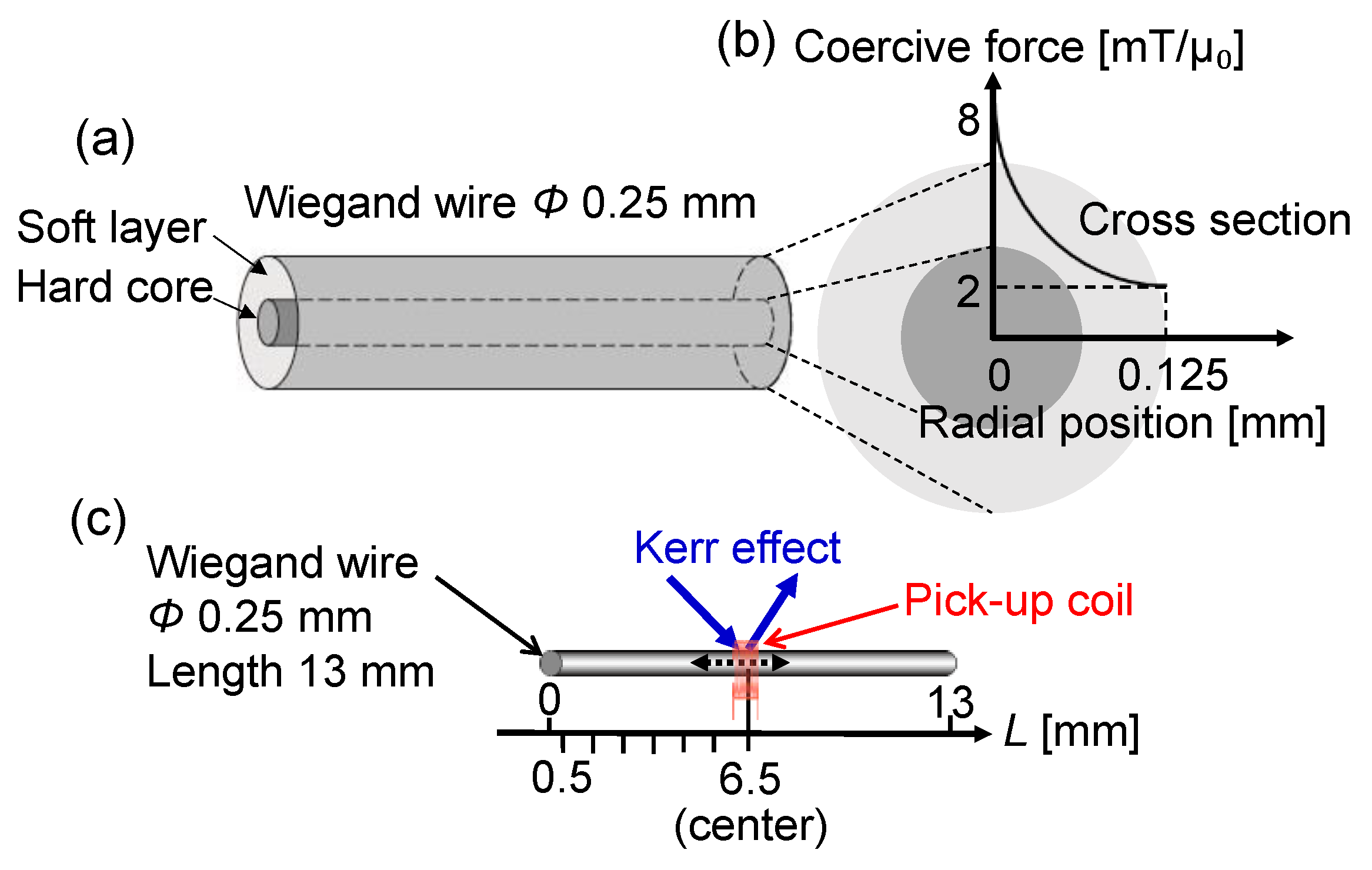
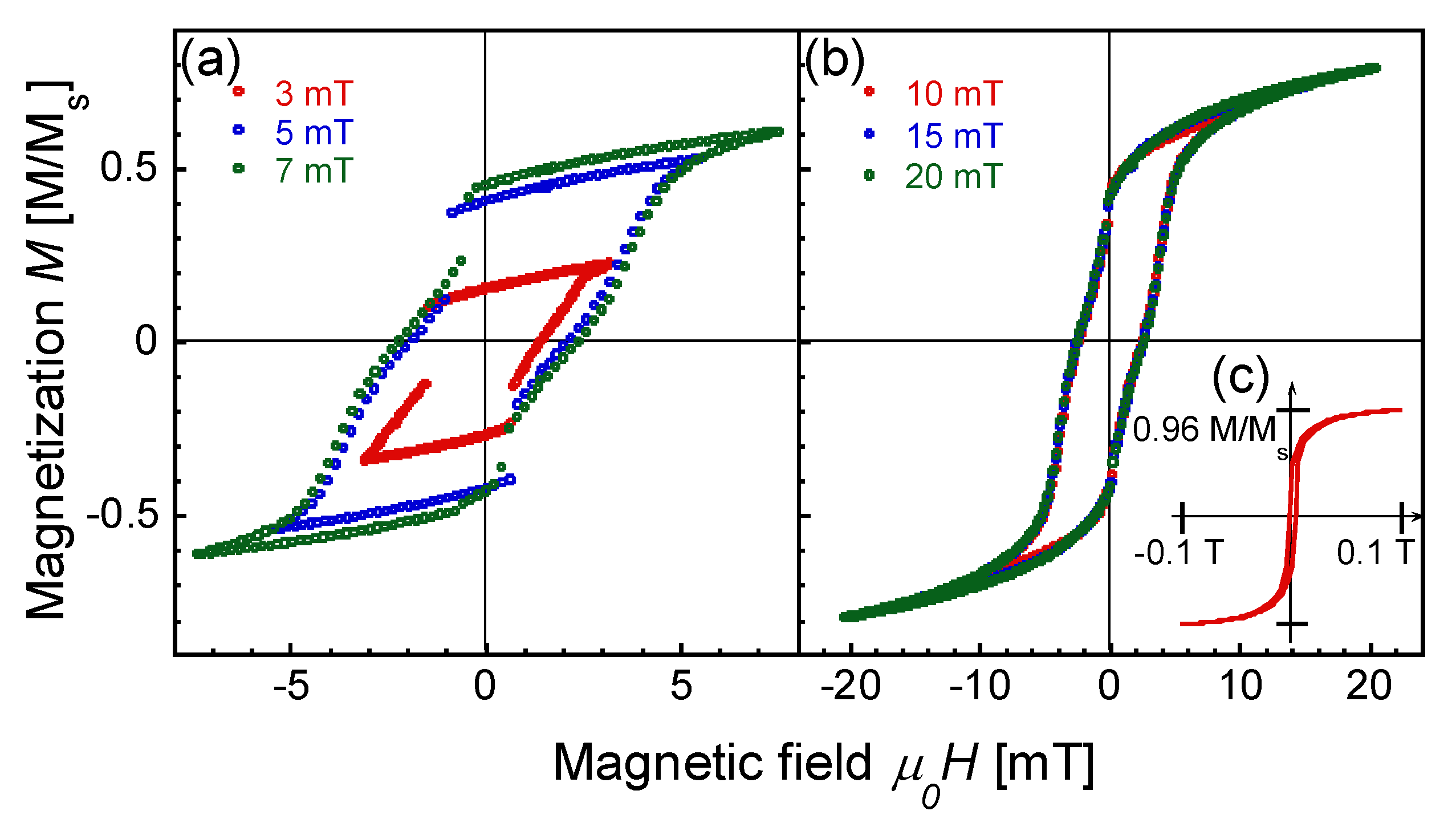
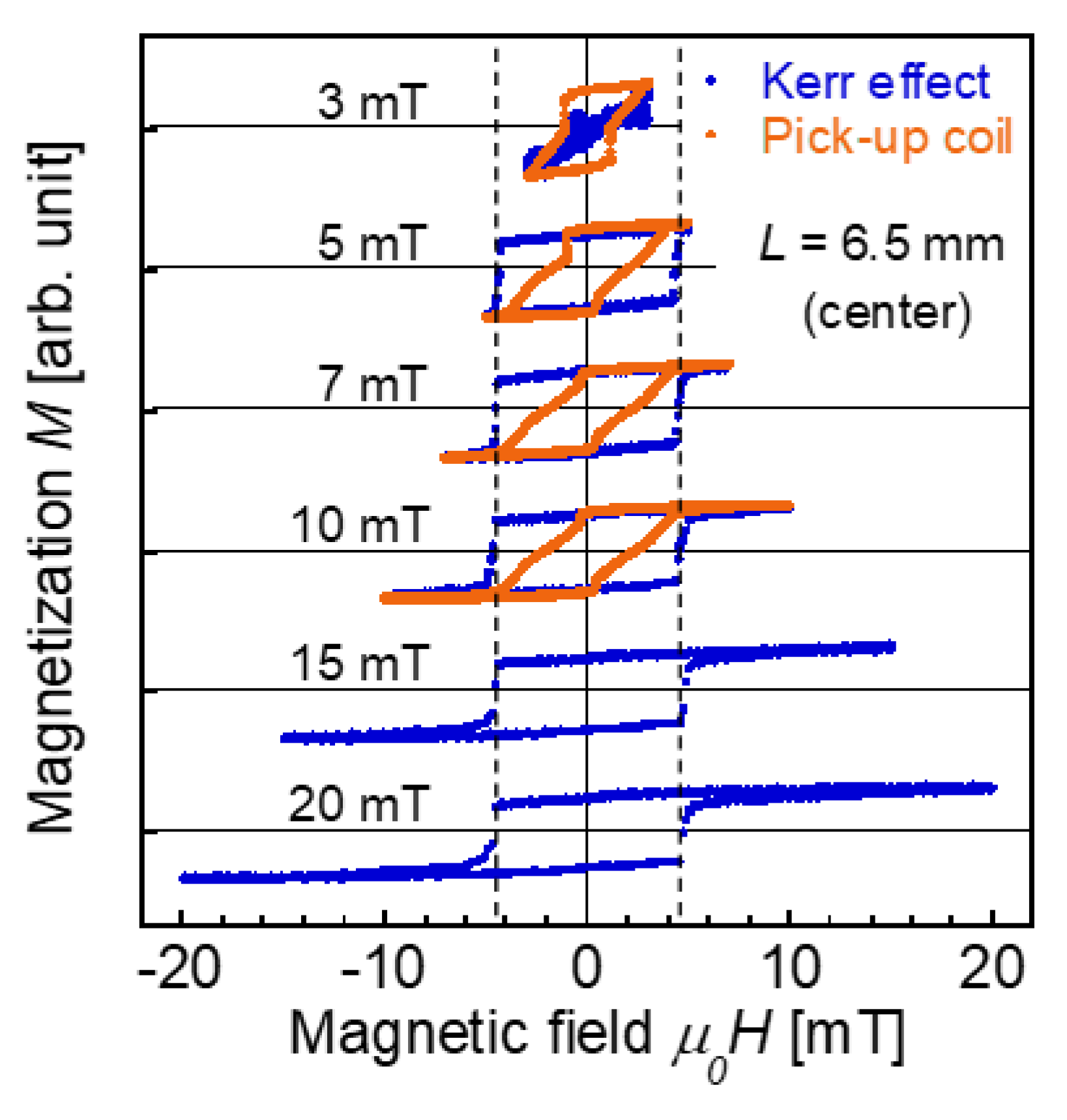
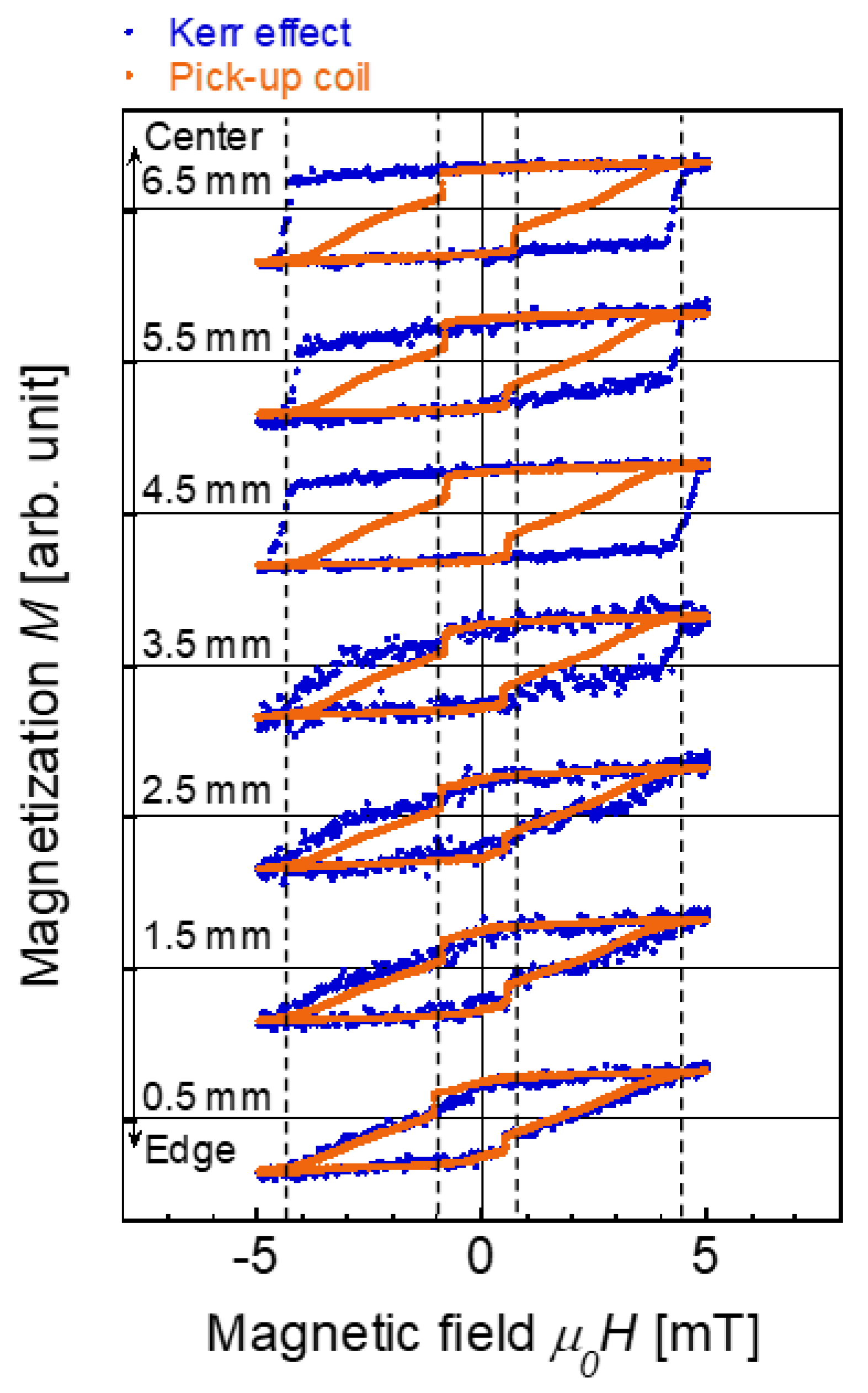
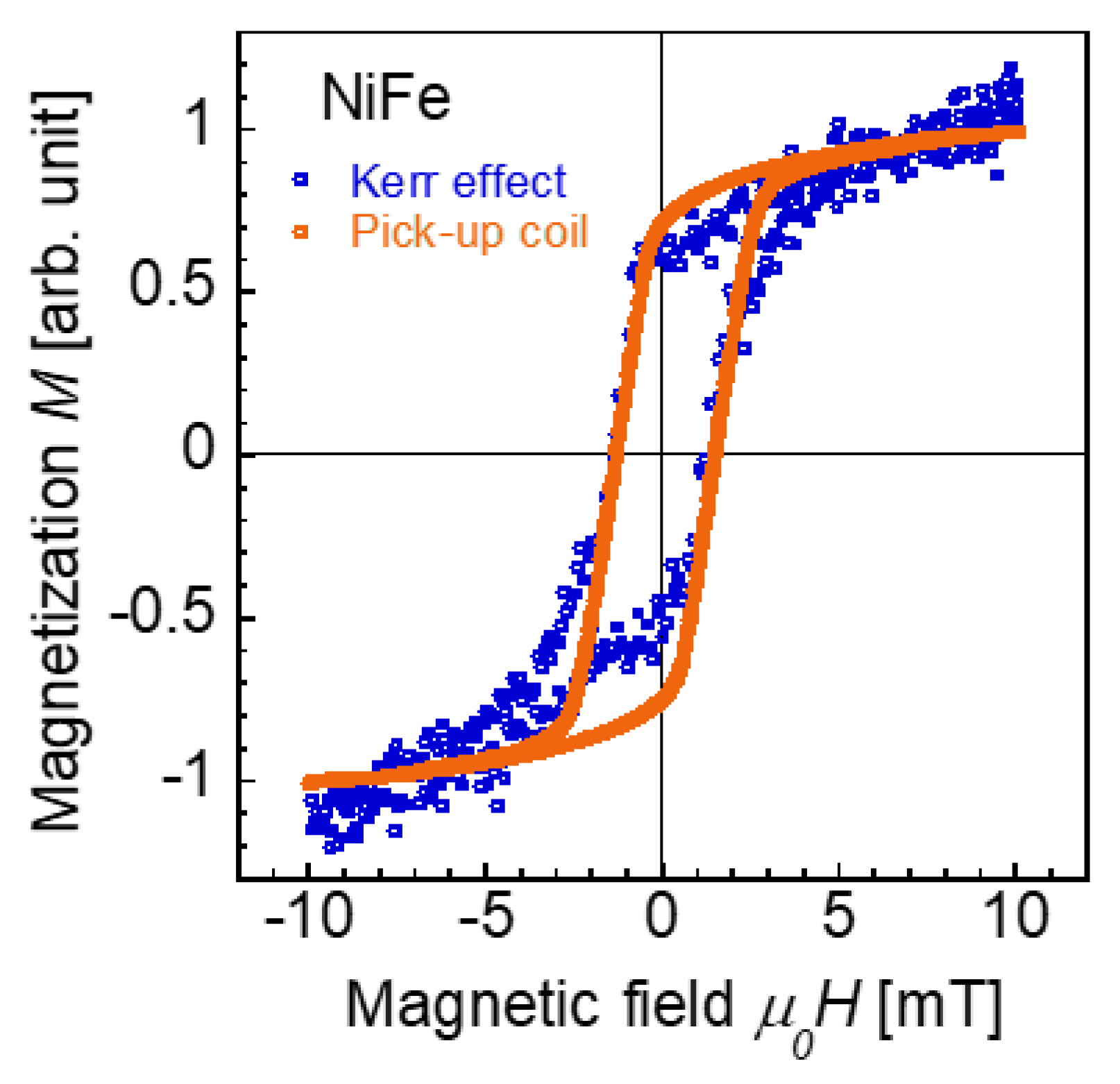
Publisher’s Note: MDPI stays neutral with regard to jurisdictional claims in published maps and institutional affiliations. |
© 2021 by the authors. Licensee MDPI, Basel, Switzerland. This article is an open access article distributed under the terms and conditions of the Creative Commons Attribution (CC BY) license (https://creativecommons.org/licenses/by/4.0/).
Share and Cite
Nakamura, T.; Tanaka, H.; Horiuchi, T.; Yamada, T.; Takemura, Y. Surface Magnetization Reversal of Wiegand Wire Measured by the Magneto-Optical Kerr Effect. Materials 2021, 14, 5417. https://doi.org/10.3390/ma14185417
Nakamura T, Tanaka H, Horiuchi T, Yamada T, Takemura Y. Surface Magnetization Reversal of Wiegand Wire Measured by the Magneto-Optical Kerr Effect. Materials. 2021; 14(18):5417. https://doi.org/10.3390/ma14185417
Chicago/Turabian StyleNakamura, Tomoaki, Hiroki Tanaka, Tomofumi Horiuchi, Tsutomu Yamada, and Yasushi Takemura. 2021. "Surface Magnetization Reversal of Wiegand Wire Measured by the Magneto-Optical Kerr Effect" Materials 14, no. 18: 5417. https://doi.org/10.3390/ma14185417
APA StyleNakamura, T., Tanaka, H., Horiuchi, T., Yamada, T., & Takemura, Y. (2021). Surface Magnetization Reversal of Wiegand Wire Measured by the Magneto-Optical Kerr Effect. Materials, 14(18), 5417. https://doi.org/10.3390/ma14185417





